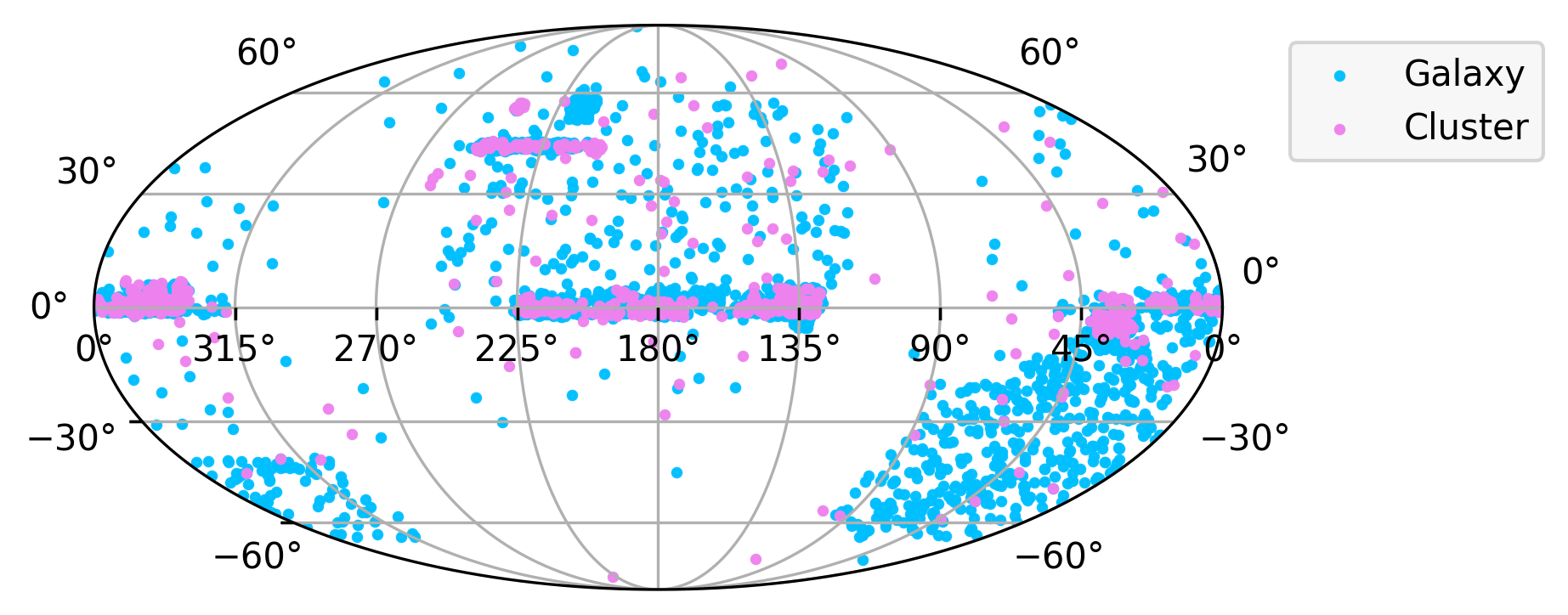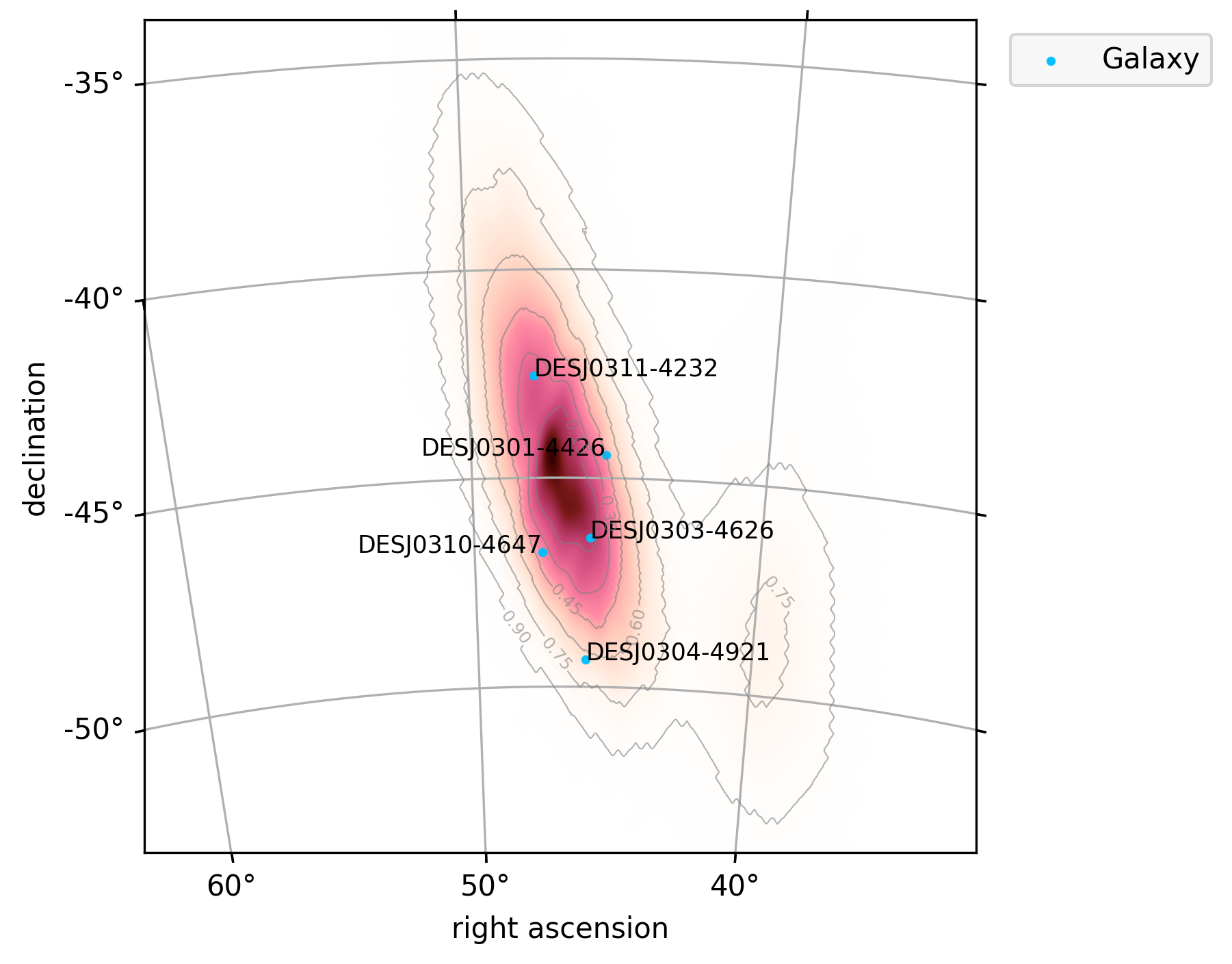A public and community-maintained catalog of known strong gravitational lenses
Project description
$\texttt{lenscat}$
A public and community-contributed catalog of known strong gravitational lenses.
Quickstart
The catalog is available as a plain csv file under lenscat/data/catalog.csv. Alternatively, one can interact with the catalog using a web app (mobile-friendly).
We also provide a python package lenscat, available in pypi. Simply do
pip install lenscat
to install the latest version. Here we adopt the continuous deployment paradigm (similar to astroquery). Whenever there is a change in the catalog content, or a major change in the code, a new release will be available instantaneously on both GitHub and PyPI.
The code converts the catalog in the csv file into a custom Catalog object that is inherited from the Table object in astropy. To access the catalog, simply run
import lenscat; lenscat.catalog
and this will show a formatted table to the output. For example,
<Catalog length=4587>
name RA DEC zlens type grading
deg deg
str20 float64 float64 str15 str7 str9
------------- ---------- -------- -------- ------- ---------
J0011-0845 2.83435 -8.7643 - galaxy confirmed
J0013+5119 3.348077 51.3183 - galaxy confirmed
PSJ0028+0631 7.09369 6.5317 - galaxy confirmed
PSJ0030-1525 7.5636 -15.4177 measured galaxy confirmed
J0047+2514 11.9465943 25.2411 - galaxy confirmed
HE0047-1756 12.6158 -17.6693 0.407 galaxy confirmed
... ... ... ... ... ...
235614+023115 359.05923 2.52107 0.372 galaxy probable
235730+010133 359.377643 1.02596 0.638 galaxy probable
235811+003309 359.5475 0.5527 0.639 cluster probable
235853+012406 359.721708 1.401816 0.481 galaxy probable
235933+020823 359.8897 2.1398 0.43 cluster confirmed
235948-005913 359.95245 -0.98702 0.758 galaxy probable
235952+004154 359.9698 0.6985 0.267 cluster probable
Note that the code will try to assign the unit for each of the columns inferred from its name, and that it will hide the 'ref' column by default. One can show or hide the 'ref' column by calling .show_ref() and .hide_ref() on the Catalog object respectively.
Every Catalog object supports three features: basic searching with .search(), crossmatching with a skymap with .crossmatch(), and visualizing with .plot(). Note that these function will return a Catalog object, and hence they can be composed together (e.g., .crossmatch().search()).
Basic searching
This feature is implemented as .search(). One can search/filter by any combination of
- ranges of right ascension (specified as
RA_range=(RA_min, RA_max)) - ranges of declination (specified as
DEC_range=(DEC_min, DEC_max)) - ranges of lens redshift if available (specified as
zlens_range=(zlens_min, zlens_max)) - type of the lenses (specified as
lens_type) - grading of the lenses (specified as
grading)
For example, to get a list of the cluster-scale lenses which are confirmed and with a redshift $z_{\mathrm{lens}} \geq 1$ together with the reference, run
import lenscat, numpy
lenscat.catalog.search(grading="confirmed", lens_type="cluster", zlens_range=(1,numpy.inf)).show_ref()
The output would be something like
<Catalog length=3>
name RA DEC zlens type grading ref
deg deg
str20 float64 float64 str15 str7 str9 str171
------------- --------- --------- ----- ------- --------- ------------------------------------------------------------------
021118-042729 32.827087 -4.458069 1.02 cluster confirmed https://arxiv.org/abs/2004.00634 More et al. 2012 More et al. 2016
023100-062139 37.7516 -6.3608 1.17 cluster confirmed https://arxiv.org/abs/2002.01611
220859+020655 332.2495 2.1153 1.04 cluster confirmed https://arxiv.org/abs/2002.01611
Crossmatching with a skymap
This feature is implemented as .crossmatch(). This function is simply a wrapper to the crossmatch() function in ligo.skymap which performs the cross-matching of a gravitational-wave (GW) skymap with a given list of coordinates. For example, to cross-match the GW skymap of GW170814 (download from here) with only the confirmed lenses in the lenscat catalog, simply run
import lenscat
lenscat.catalog.search(lens_type="galaxy").crossmatch("GW170814_skymap.fits.gz")
Running this will give
<Catalog length=3818>
name RA DEC zlens type grading searched probability searched area
deg deg deg2
str20 float64 float64 str15 str7 str9 float64 float64
-------------- ---------- --------- ------ ------ --------- -------------------- ------------------
DESJ0303-4626 45.9507 -46.44066 1.37 galaxy probable 0.11857081625736535 2.59328622407046
DESJ0311-4232 47.86322 -42.53863 0.37 galaxy probable 0.2301796464718608 5.619333233953008
DESJ0310-4647 47.63526 -46.78398 0.71 galaxy probable 0.36778302134840013 10.261676209026643
DESJ0301-4426 45.4638 -44.44055 0.76 galaxy probable 0.4683381098641989 14.661410864782189
DESJ0304-4921 46.06729 -49.35725 0.34 galaxy confirmed 0.6465740359340766 26.791826830724982
DESJ0300-5001 45.09019 -50.02469 0.53 galaxy confirmed 0.7082286031333002 33.860252998986475
The cross-matching can be done to the sky localization from any type of transients as long as it is in the FITS format. For example, to cross-match the localization of GRB 240229A (download from here), simply run
import lenscat
lenscat.catalog.crossmatch("glg_healpix_all_bn240229588.fit")
In this case, the output would be
<Catalog length=4587>
name RA DEC zlens type grading searched probability searched area
deg deg deg2
str20 float64 float64 str15 str7 str9 float64 float64
------------------ ------------ ----------- ------ ------- --------- -------------------- ------------------
SDSSJ1320+1644* 200.24778 16.73437 0.899 galaxy confirmed 0.1614180609749184 6.9241725729921235
SDSSJ1330+1750 202.63079 17.84456 0.2074 galaxy confirmed 0.6132034472687292 44.48256319619201
SDSSJ1304+2001 196.18166 20.01805 0.4? galaxy confirmed 0.6545106150094973 51.40673576918417
SDSSJ1330+1810 202.57772 18.17581 0.373 galaxy confirmed 0.6730233044611307 54.97373376133156
SDSSJ1258+1657 194.58017 16.95489 0.4? galaxy confirmed 0.6890963497394108 58.33090834217615
To generate a visualization of a crossmatching result, simply invoke .plot() to a crossmatching result. For example,
import lenscat
lenscat.catalog.crossmatch("GW170814_skymap.fits.gz").plot(searched_prob_threshold=0.7)
will generate a figure like this
Format
| Column name | Description |
|---|---|
name |
Names of galaxies/galaxy clusters |
RA [deg] |
Right ascension in dergees |
DEC [deg] |
Declination in degress |
zlens |
Lens redshift (if known) |
type |
Type of lens (i.e. galaxy or galaxy cluster) |
grading |
Grading whether it is a confirmed lens or a probable lens (see individual references for internal grading systems) |
ref |
Reference to the corresponding catalog or study |
References
This catalog contains the known strong lenses from the following studies:
-
(COSMOS) LensFlow: A Convolutional Neural Network in Search of Strong Gravitational Lenses
-
Survey of Gravitationally-lensed Objects in HSC Imaging (SuGOHI) Candidate List
See also
Acknowledgements
This project was supported by the research grant no. VIL37766 and no. VIL53101 from Villum Fonden, and the DNRF Chair program grant no. DNRF162 by the Danish National Research Foundation.
This project has received funding from the European Union's Horizon 2020 research and innovation programme under the Marie Sklodowska-Curie grant agreement No 101131233.
We would also like to thank Jonah Kanner for introducing us the amazing streamlit service that hosts the web app for lenscat.
Project details
Release history Release notifications | RSS feed
Download files
Download the file for your platform. If you're not sure which to choose, learn more about installing packages.

















